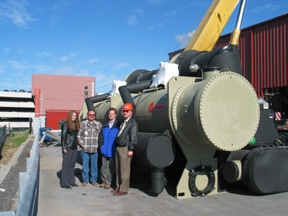 |
From left, Trane representative Stacey McWilliams, UNMC’s Paul Hathaway, Trane representative Doyle Gill and UNMC’s Robert Fuder stand beside the new water chiller. |
But, employees at Davis Erection Co. made it look easy Tuesday as they moved a new water chiller into UNMC’s Central Utilities Plant via an opening in the roof.
The new chiller, capable of 2,500 tons of cooling, replaces an old 1,500-ton steam-fired chiller.
“We replaced an old, worn out steam powered unit with a more efficient electric chiller,” said Darren Dageforde, manager of engineering services in UNMC’s Facilities, Management and Planning. “The campus needed additional base-load capacity, as well as additional capacity to address campus growth. Aside from new construction additions, the campus cooling demand is going up 3 percent to 4 percent each year simply due to the increase of electronic equipment in the workplace. Without periodic replacements and upgrades, the central utility systems would soon fall behind our ever-increasing demands.”
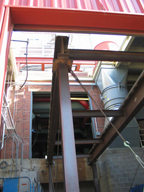 | 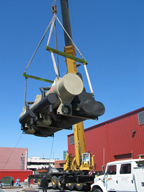 |
The chiller temporarily will sit on this steel frame once it’s lowered through the roof. | Lifting 40 tons. |
To most casual observers a chiller is simply a conglomeration of expensive steel components. To facilities personnel, however, a chiller represents a designed and specialized piece of equipment responsible for keeping campus rooms and equipment at the proper temperatures (see “How it works” info below).
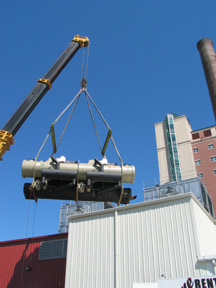 |
Positioning the new chiller above the opening in the roof of the Central Utility Plant. |
The new chiller, which stands 13 feet tall (including the platform it rests on), is capable of 2,500 tons of cooling — a typical 1,500-square-foot home uses a 3-ton air conditioning unit. The Trane chiller has two electric motor driven compressors, each rated at more than 1100 horsepower.
To place the 26-foot-long chiller, the contractor removed panels from the building’s roof so a crane could lower the chiller into the building’s second floor.
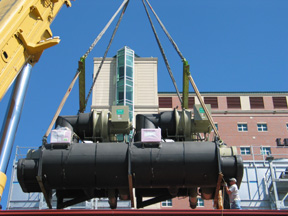 |
Lowering the new chiller. |
The LB 309 Task Force, more commonly known as the Task Force for Building Renewal, provided partial funding for the project.
“In fulfilling their mission of addressing deferred maintenance issues on state building, LB 309 has been generously supporting numerous projects on the UNMC campus for many years,” Dageforde said. “Without the support of LB 309, it would be extremely difficult to do this and other campus projects. We’re extremely grateful for their support.” The total project is expected to cost about $845,000 with the chiller accounting for a little over half the total cost, he said.
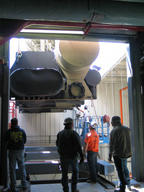 | 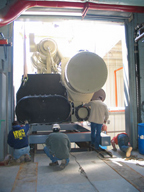 |
Inside the utility plant, the chiller is lowered onto a gray frame, which sits atop the steel framework. | The chiller and gray frame will be slid in place to its permanent location on the second floor. |
How it works
Campus buildings are cooled using a central chilled water system, which pumps cold water (about 40 degrees Fahrenheit) from the Central and East Utility Plants to the buildings through a grid of distribution piping. At each building, the water is circulated through air conditioning units, where the building supply air is cooled and the heat is transferred to the cooling water. The water, now approximately 52 degrees Fahrenheit, is circulated back to the utility plants where the heat is removed via the chiller and then circulated back to the campus repeating the cycle.
The heat energy that is removed from the chilled water by the chiller is pushed into a separate cooling tower water loop. The tower loop circulates the heated water through a cooling tower where the heat energy is released to the atmosphere via a process know as evaporative cooling. The cooled water from the tower is then pumped back through the chiller, continuously repeating its cycle. The tower water system generally operates in the 75 to 95 degree Fahrenheit range. In theory, the whole system is really just a large variation of a standard car or home air condition system, with a few minor adjustments to improve capacity and efficiency.